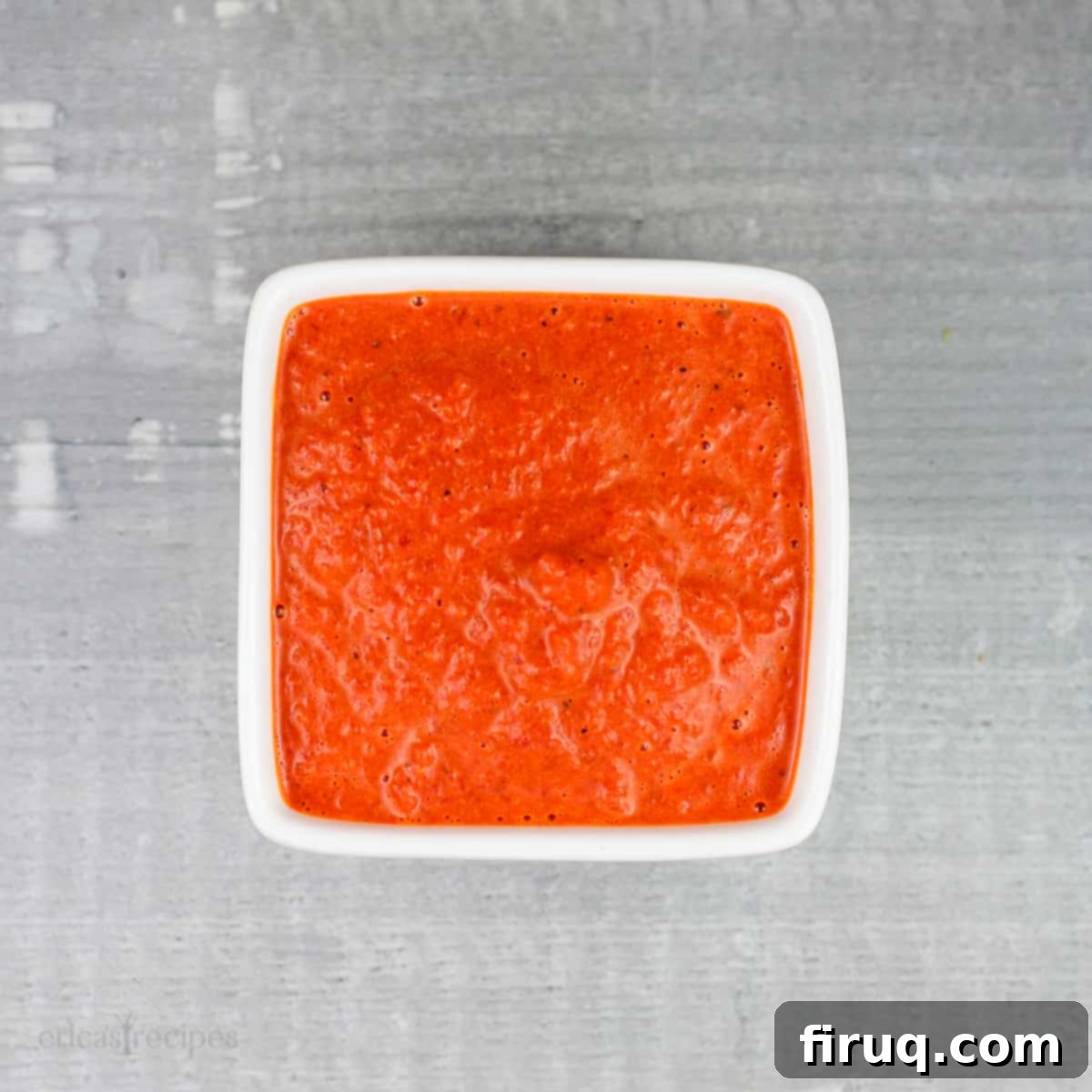Easy & Versatile Roasted Red Pepper Coulis: Your Ultimate Homemade Sauce Guide
Discover the delightful simplicity of homemade Red Pepper Coulis – a vibrant and incredibly versatile sauce that will elevate countless dishes. Crafted with a harmonious blend of sweet roasted red peppers, aromatic onion, pungent garlic, and a subtle hint of balsamic vinegar, this coulis offers a depth of flavor that is both comforting and sophisticated. Far from being an exclusive gourmet item, this roasted red pepper sauce is surprisingly easy to prepare, making it a perfect addition to your culinary repertoire. Imagine drizzling this rich, flavorful purée over your morning eggs, enhancing a simple sandwich, lending a gourmet touch to roasted vegetables, or even transforming a bowl of soup into a culinary masterpiece. Its adaptability knows no bounds, making it a true kitchen hero.
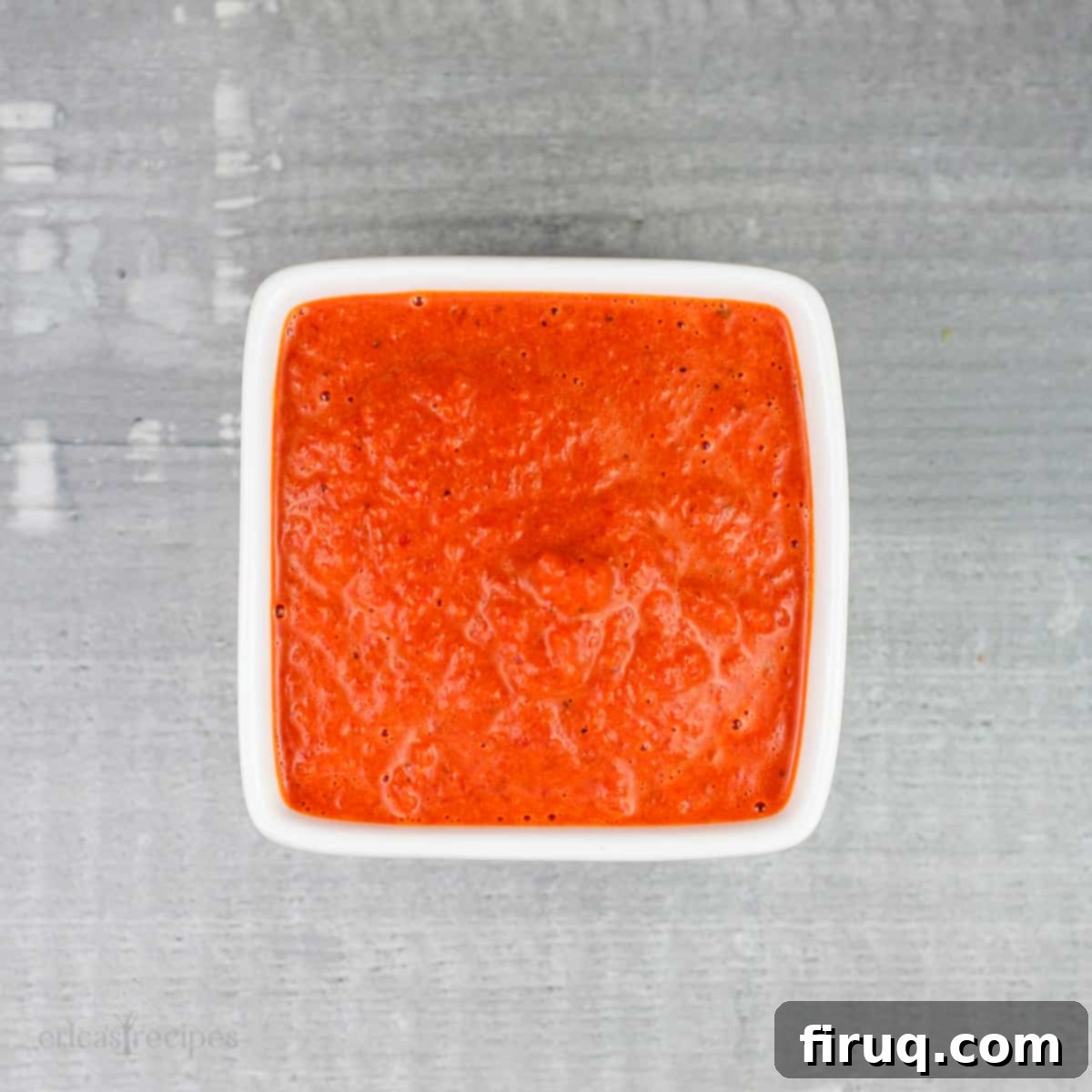
What Exactly is a Coulis? Understanding This Classic Sauce
A coulis (pronounced “koo-LEE”) is a culinary term for a thick sauce made from puréed fruits or vegetables. It’s often associated with fine dining, but its essence is quite straightforward. Historically, coulis were designed to be thinner and meticulously strained to achieve an exceptionally smooth, uniform consistency, almost like a liquid velvet. A classic example is a vibrant raspberry coulis, frequently served to complement the rich creaminess of cheesecake, adding a burst of fresh fruit flavor and a striking visual contrast. Another common application might be a vegetable coulis, used to enhance the presentation and taste of main courses, often acting as a colorful and flavorful base.
However, while traditional coulis recipes often emphasize straining and achieving a specific thinness, our approach to this particular red pepper coulis embraces a slightly different philosophy. We opt for a thicker, more rustic texture that doesn’t require straining. This choice isn’t just about saving time; it’s about preserving the full, robust flavor and beneficial fiber from the peppers, onion, and garlic. The “yumyums of flavor” – those tiny, textural elements that contribute to a more wholesome mouthfeel – are intentionally kept in. This results in a sauce that is wonderfully rich and substantial, perfect for coating foods rather than just lightly glazing them. This slightly thicker consistency makes it exceptionally versatile for applications like spreading on sandwiches, topping scrambled eggs, or serving alongside fish and roasted vegetables, providing a more satisfying and hearty experience than a purely liquid sauce. This allows the homemade roasted red pepper sauce to perform double duty as both a gourmet drizzle and a flavorful spread.
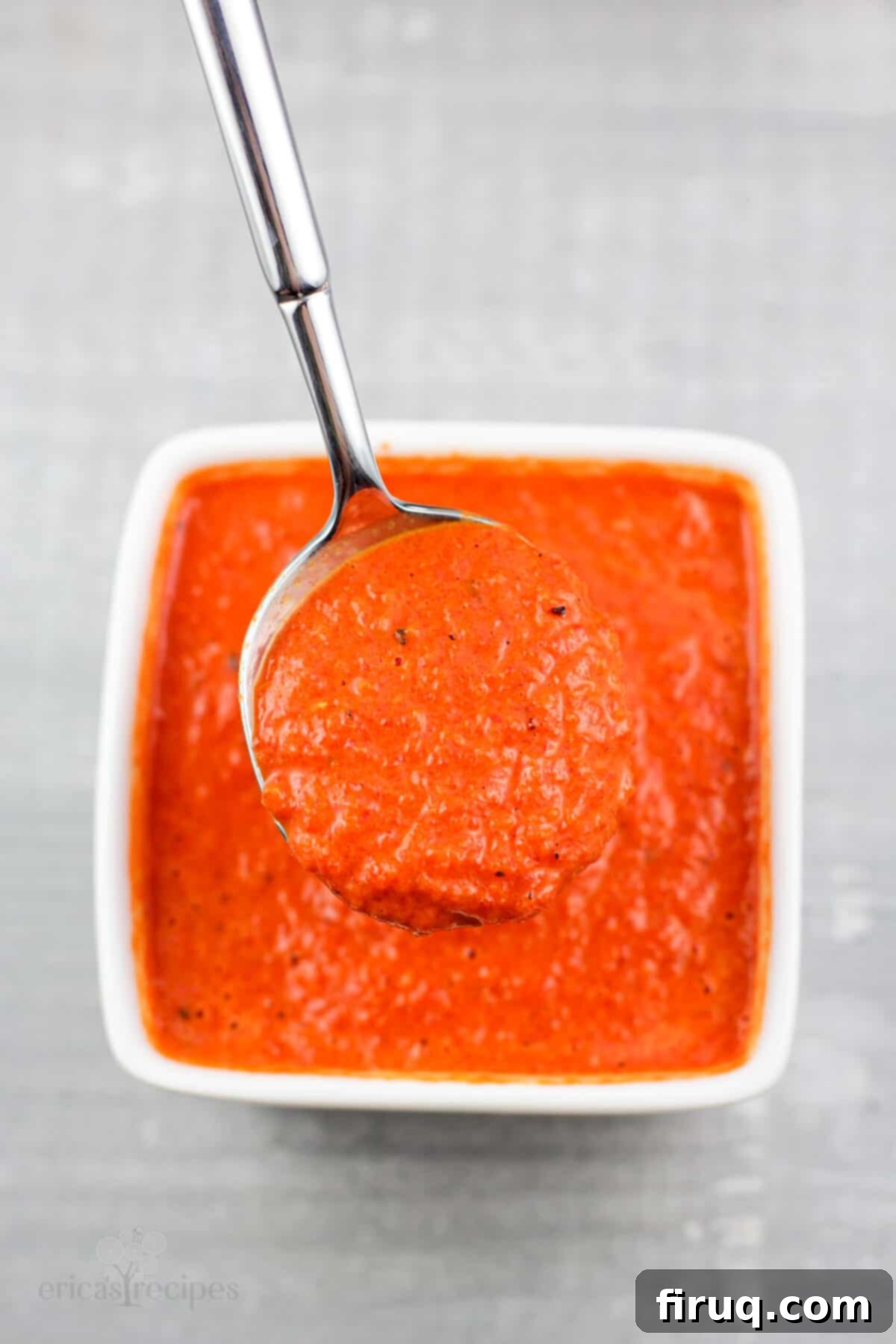
Why This Roasted Red Pepper Coulis Recipe Is a Must-Try
This roasted red pepper sauce isn’t just good; it’s *exceptionally* good, and its success lies in its perfect balance of intense flavor and remarkable ease of preparation. We live in a world where delicious, homemade food doesn’t have to be complicated, and this coulis is a testament to that. The entire process is incredibly straightforward: a quick sauté of aromatics, a blend of key ingredients, and a brief simmer to marry the flavors. That’s it! There’s no need for arduous straining or intricate techniques, which often deter home cooks from trying gourmet-sounding recipes. By foregoing the straining process, we intentionally retain all the natural fibers and concentrated flavors of the roasted peppers, onion, and garlic. This deliberate choice contributes to a thicker, more substantial sauce that clings beautifully to food, delivering a burst of taste in every bite.
The resulting texture is wonderfully rich and velvety, making it ideal for a myriad of culinary uses. It’s thick enough to be a delightful spread on gourmet sandwiches, a robust topping for perfectly scrambled eggs, or an exquisite accompaniment to flaky white fish. Imagine it drizzled generously over a medley of freshly roasted seasonal vegetables, adding a touch of Mediterranean warmth and sweetness. This versatile sauce provides an instant flavor boost to almost any savory dish, transforming everyday meals into something special. It even makes a fantastic, unexpected pairing for more intricate dishes, such as my acclaimed Pesto Chicken Crepes, where its vibrant color and savory notes provide a brilliant counterpoint to the pesto and chicken. This easy recipe truly works because it delivers maximum flavor with minimal effort, proving that gourmet taste can indeed be accessible and simple to achieve in your own kitchen.
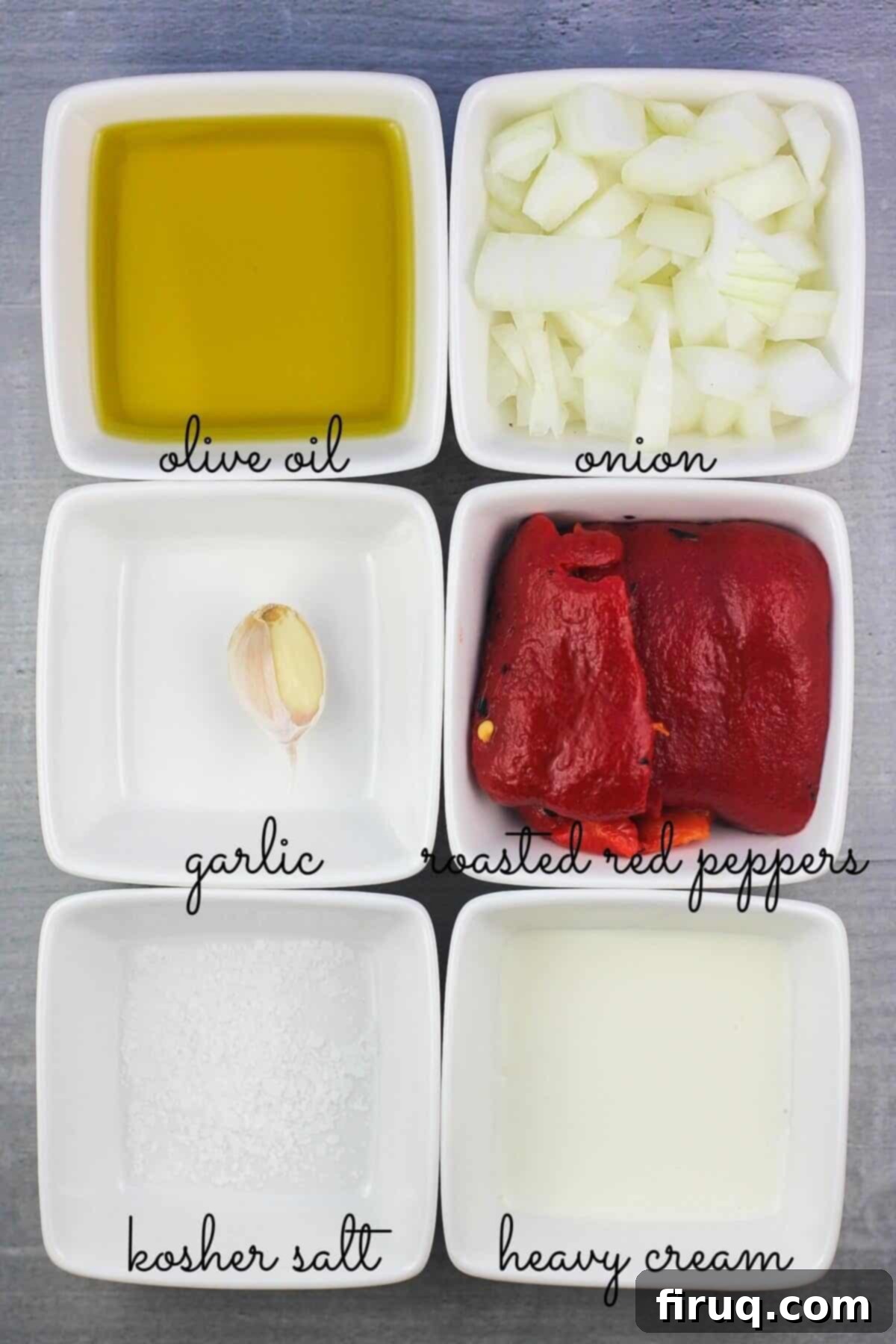
Crafting Your Own Red Pepper Coulis: A Simple Step-by-Step Guide
Preparing this exquisite roasted red pepper sauce is genuinely one of the easiest culinary tasks you’ll undertake. In fact, I’d venture to say it’s among the simplest, most rewarding sauces on my entire blog. While favorites like my homemade pizza sauce and zesty ranchero sauce are certainly user-friendly, this red pepper coulis takes “stupid simple” to a whole new level without compromising on flavor or sophistication. Let’s break down the effortless steps to create this incredibly flavorful sauce.
First, begin by heating a tablespoon of the finest olive oil in a skillet over medium-high heat. Once shimmering, add your finely chopped onion and garlic. Sauté them gently, tossing regularly, until they become beautifully softened and release their intoxicating aroma. This step is crucial for building the foundational flavor of your coulis, ensuring that the pungent raw edge of the aromatics is mellowed into a sweet, fragrant base. The caramelized notes from the sautéed onion and garlic will add a wonderful depth to the finished sauce. Once perfectly tender and golden, carefully transfer this aromatic mixture into your food processor.
Next, it’s time to introduce the stars of the show! Add the remaining ingredients to the food processor – that’s the beautifully roasted red bell peppers (ensuring they are well-drained to avoid excess liquid, which can dilute the flavor), a pinch of kosher salt to enhance all the flavors, the luxurious heavy cream (which adds a wonderful richness and smooth texture), and the rest of your extra virgin olive oil. Hold off on the balsamic vinegar for now; it gets added in a later stage. Process or blend these ingredients until the mixture achieves a wonderfully smooth and creamy consistency. You want it to be thoroughly puréed, with no large chunks remaining, creating that signature coulis texture that is both appealing to the eye and the palate.
Once blended, transfer this vibrant mixture to a small saucepan. Now, it’s time to incorporate the balsamic vinegar. Add it in and let the sauce gently simmer for about 10 minutes, stirring frequently. This simmering stage serves several vital purposes: it allows all the beautiful flavors to meld and deepen, concentrates the sauce to a perfect consistency, and fully integrates the tangy balsamic vinegar, which adds a crucial layer of acidity and complexity that brightens the overall taste. Be mindful that because this sauce is intentionally thick, it won’t truly “simmer” in the traditional sense of a gentle bubble. Instead, it might produce large, messy bubbles and tend to splatter. To keep your stovetop clean and ensure even cooking, it’s essential to “babysit” the sauce – stir it often and consistently to prevent sticking and splattering. This small effort will ensure a perfect, mess-free result, yielding approximately 1-½ cups (12 ounces) of this delightful sauce.
PRO TIP for Drizzling Perfection! If you want to achieve that elegant zig-zag pattern or beautifully precise lines of sauce often seen in restaurant plating, you have a couple of fantastic options. A simple, yet highly effective method, is to use a sturdy ziploc bag. Just snip off a tiny corner, fill it with your coulis, and gently squeeze to create controlled lines. Alternatively, for more precision and convenience, invest in a proper drizzle bottle (often found in kitchen supply stores or online). I’ve personally used both methods, and they are equally effective at creating stunning garnishes. However, the drizzle bottle often offers superior control, allowing for finer lines and easier storage of any leftover sauce, making it a favorite for regular use in your kitchen.
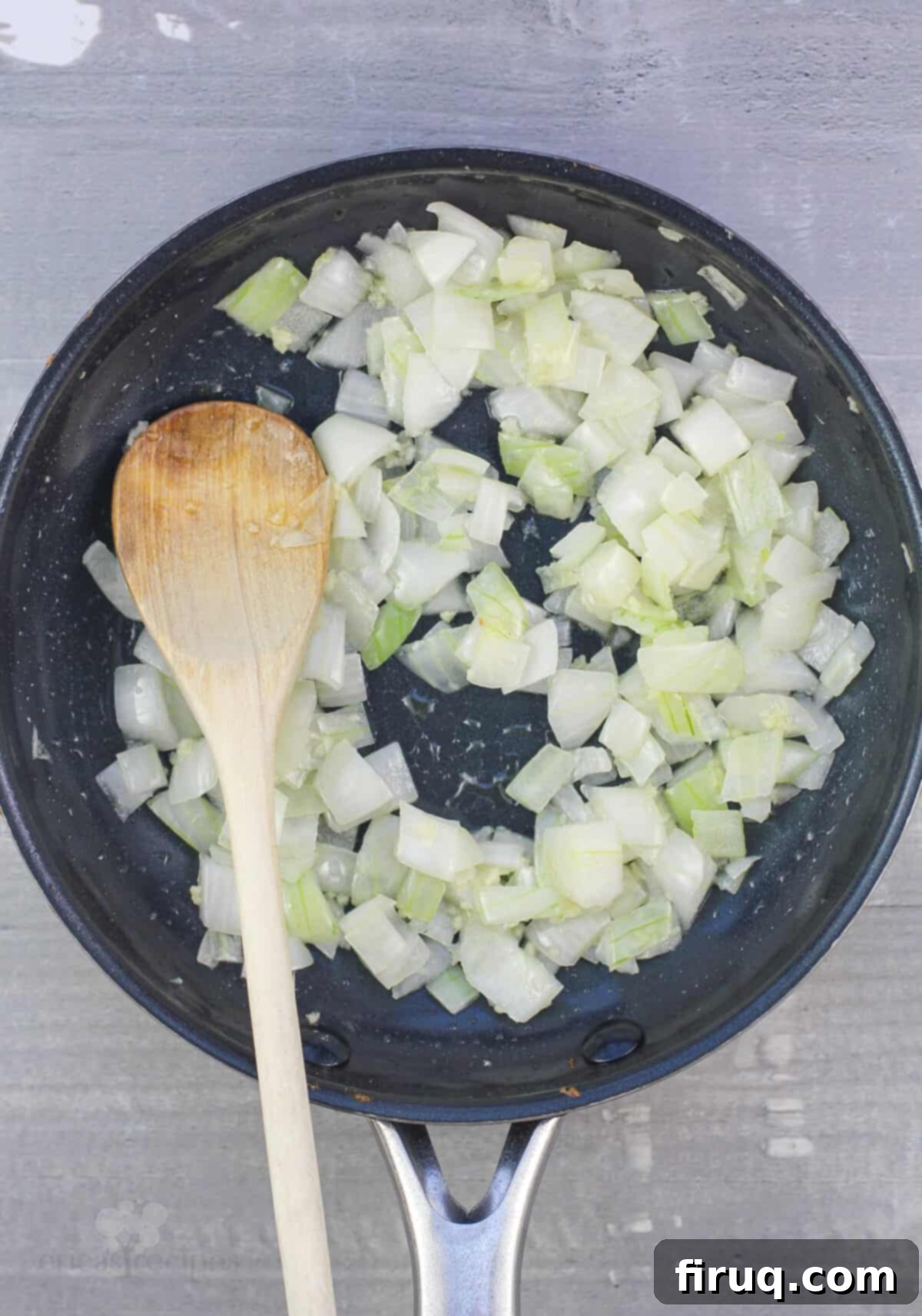
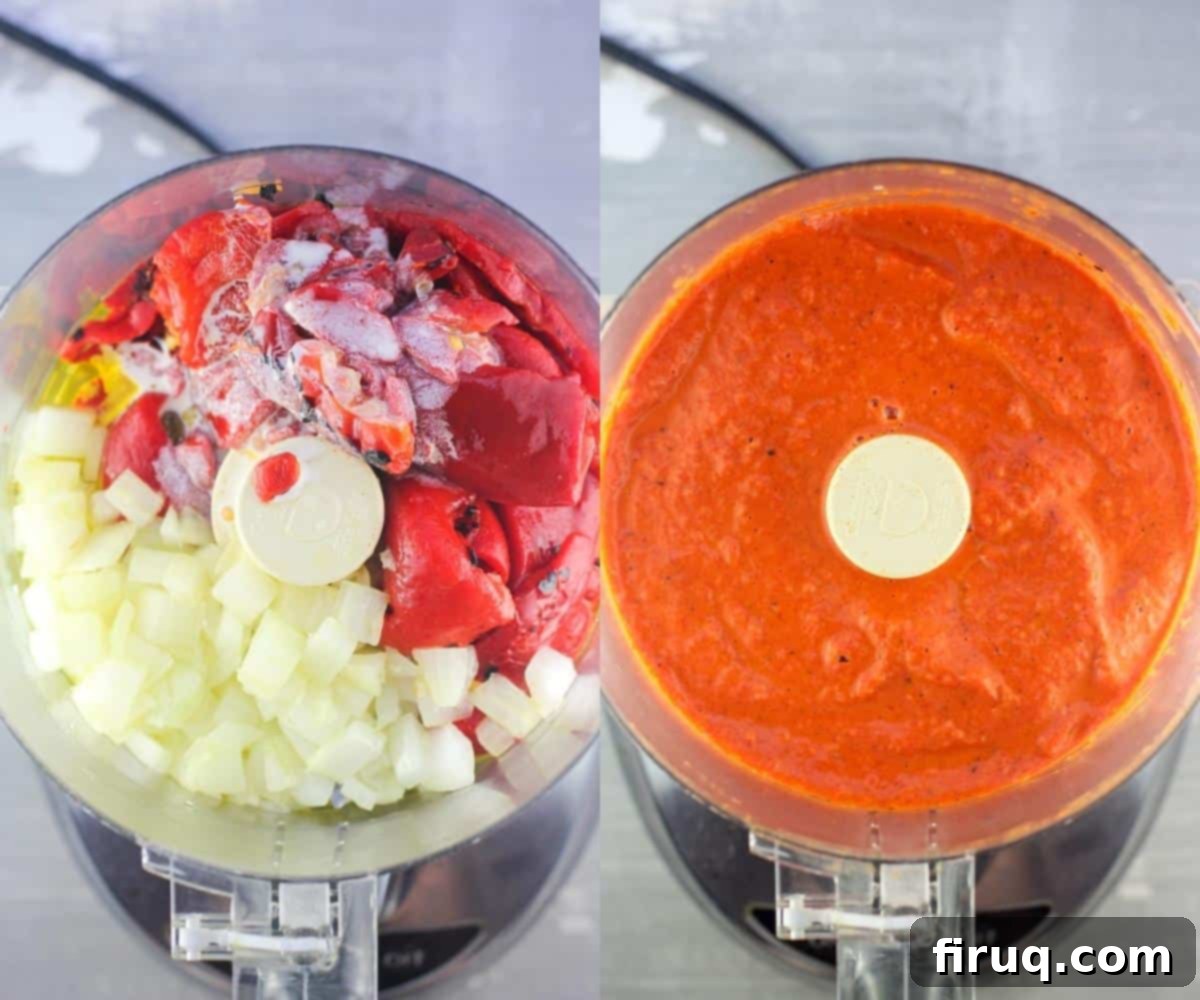
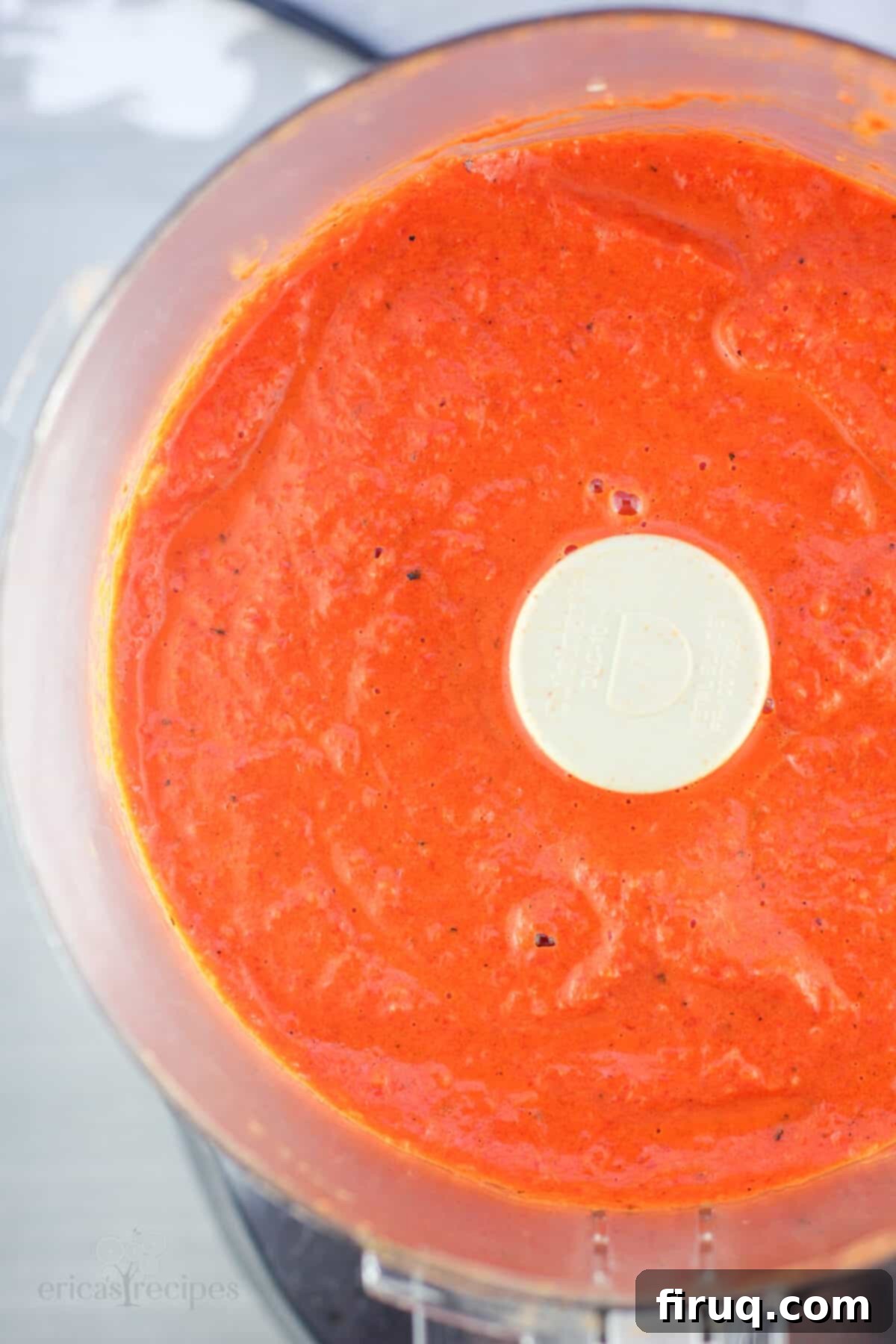
Tailoring Your Roasted Red Pepper Sauce: Achieving the Perfect Consistency
One of the beauties of homemade sauces like this red pepper coulis is the ability to customize its consistency to perfectly suit your preferences and intended use. I personally adore my red pepper sauce on the thicker side; it provides a more substantial texture that works wonderfully as a spread or a hearty topping, clinging beautifully to foods. However, if your culinary vision calls for a thinner, more traditional coulis consistency – one that flows more freely and coats subtly – achieving this is quite simple and puts you in complete control of your sauce.
To thin the sauce, the best approach is to incorporate some chicken or vegetable stock during the simmering phase. Start by adding about ½ cup of stock. After adding, continue to simmer the mixture. The key here isn’t just dilution but ensuring the flavors remain concentrated. Therefore, you’ll want to gently simmer the sauce until approximately half of the added liquid has reduced. This process allows the water content to evaporate while the rich flavors intensify, preventing the sauce from becoming watery or bland. You can adjust the amount of stock incrementally, adding a little more and reducing if you desire an even thinner consistency, until it reaches your ideal pourable texture for your culinary creation.
Another delightful way to adjust the thickness and add a touch of creaminess is by incorporating an additional tablespoon of heavy cream. This isn’t just for thinning; it also enriches the sauce, making it even more luscious and velvety. Do note that adding more cream will subtly lighten the vibrant red hue of the coulis, giving it a softer, more pinkish tone. This is a common practice in many sauce preparations and can add another dimension to the flavor profile, making it slightly richer and more indulgent, particularly appealing for those who enjoy a creamy texture.
Conversely, if you find your coulis is too thin for your liking and you prefer an even thicker consistency, the solution is straightforward: simply continue to simmer it gently to boil off excess liquid. As mentioned in the main recipe instructions and notes, remember that this thick sauce won’t typically “simmer” with gentle bubbles. Instead, it will tend to pop and splatter vigorously. To manage this and prevent a messy kitchen, ensure you stir the sauce very often and consistently during the reduction process. Frequent stirring will help evaporate the liquid evenly, prevent scorching, and keep those lively bubbles from creating a mess, ensuring you achieve a perfectly thick, rich, and concentrated roasted red pepper sauce.
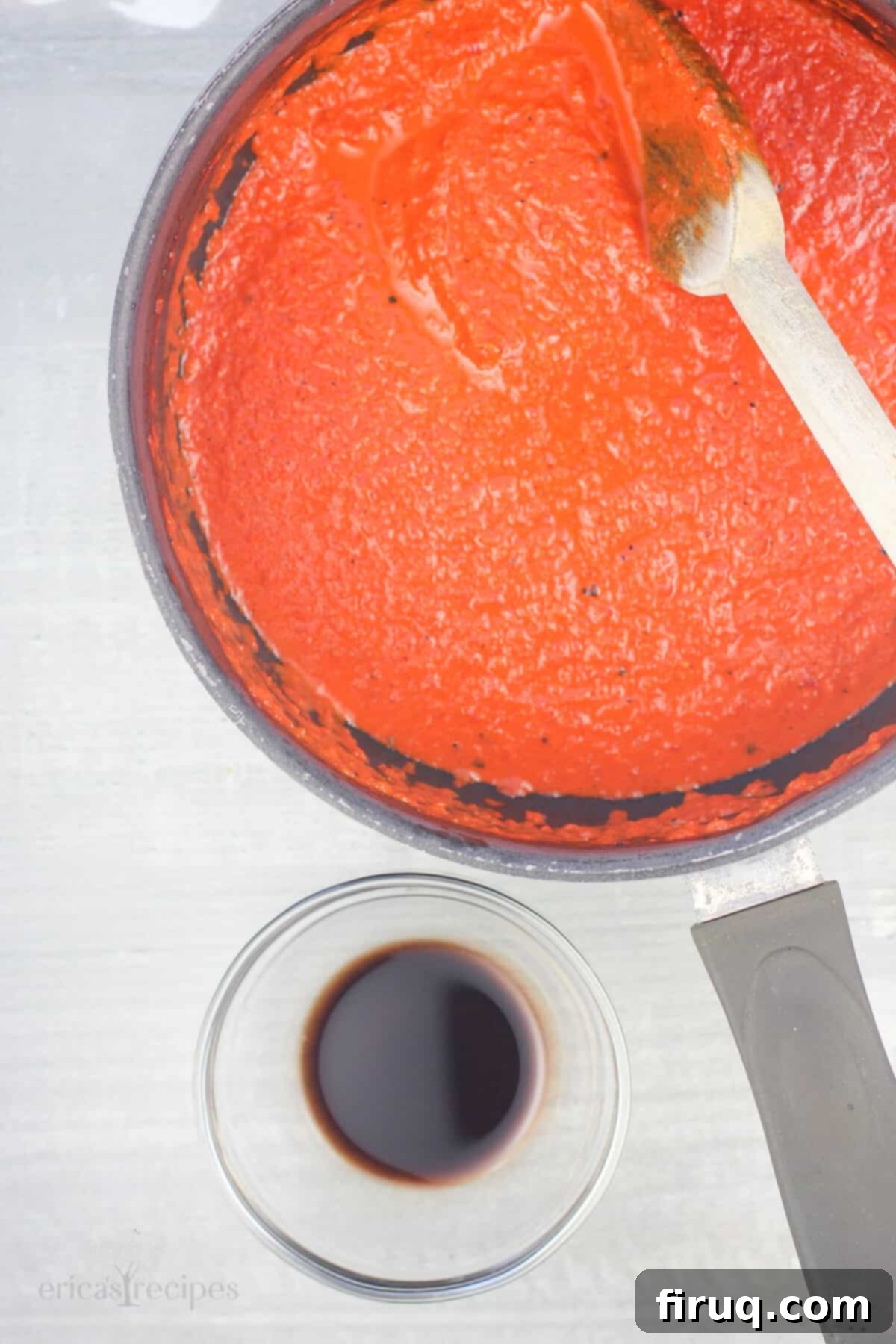
Optimal Storage for Your Red Pepper Coulis
Proper storage is key to maintaining the vibrant flavor and beautiful color of your homemade red pepper coulis. Due to its naturally acidic nature and deep red pigment, this sauce has a tendency to stain plastic containers over time, which can be an annoyance. To preserve its pristine quality and avoid any unwanted discoloration of your storage ware, it is highly recommended to store the coulis in an airtight glass container, such as a mason jar or a good quality glass food storage container. Glass not only prevents staining but also offers a superior barrier against odors, ensuring your coulis retains its fresh, rich flavor profile without picking up any unwanted tastes from its surroundings.
How Long Will Red Pepper Coulis Stay Fresh?
This delicious roasted red pepper sauce boasts excellent keeping qualities, making it ideal for meal prep or enjoying throughout the week. When stored correctly in an airtight glass container in the refrigerator, your coulis will remain fresh and flavorful for up to one week. For longer preservation, it freezes beautifully. Simply transfer the coulis to freezer-safe containers or even individual ice cube trays (for convenient single servings), and it will maintain its quality for up to one month. Thaw in the refrigerator overnight before use or gently reheat from frozen over low heat for quick application, ensuring you always have this versatile sauce on hand.
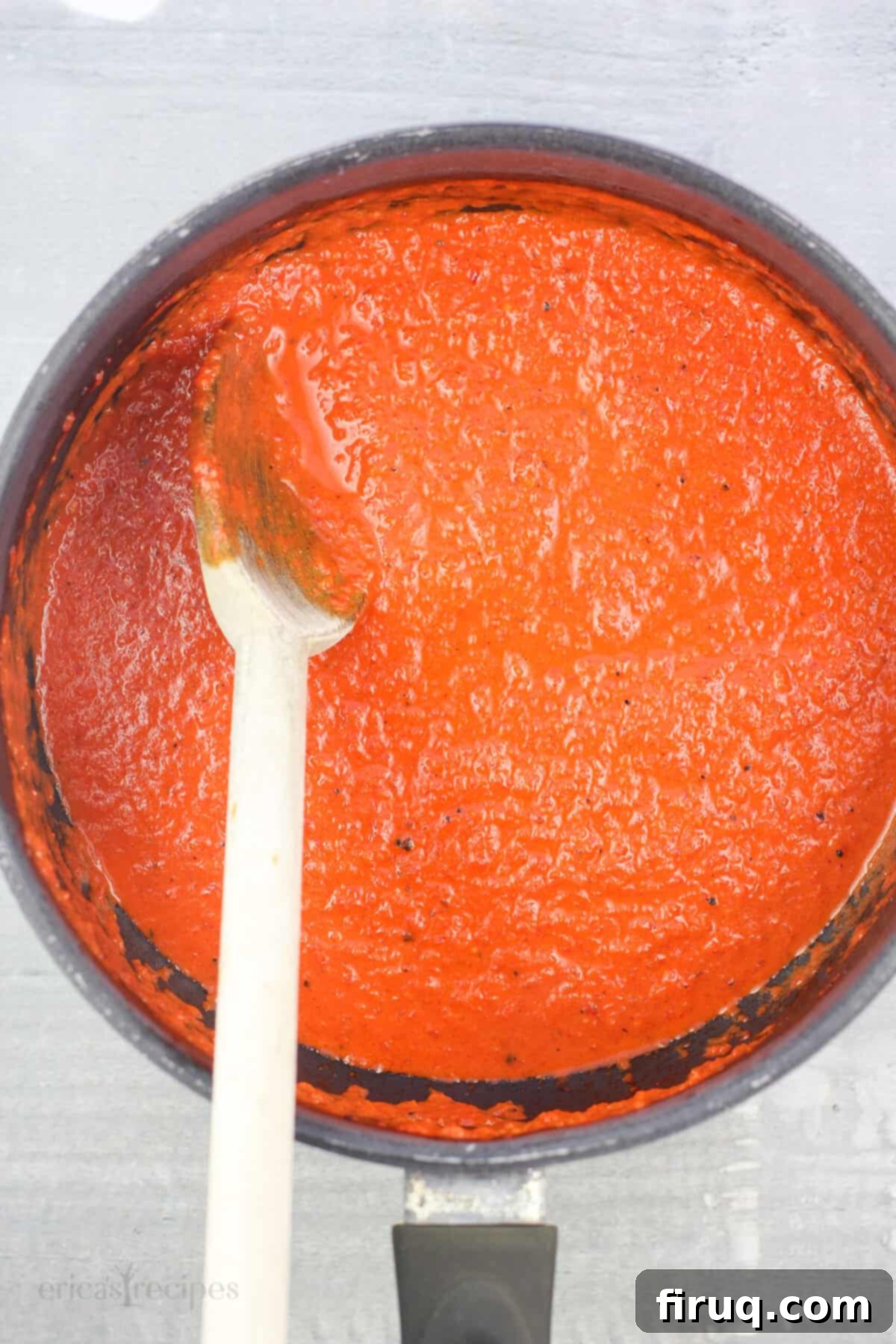
Creative Ways to Enjoy Your Versatile Red Pepper Coulis
The true magic of this roasted red pepper coulis lies in its incredible versatility. Once you have a batch ready, you’ll find endless opportunities to incorporate its vibrant flavor and color into almost any meal. Here’s a little brainstorming to spark your culinary imagination and show you just how many dishes this sauce loves to enhance:
- Eggs, Glorious Eggs: From a simple scrambled breakfast to an elaborate brunch, this coulis is a game-changer. Drizzle it over soft, runny over-easy eggs, mix it into fluffy scrambled eggs, spoon it onto elegant Eggs Benedict, or use it to elevate a rustic frittata or a delicate omelet. Any egg dish you can name will benefit from its savory, sweet notes.
- Crepes, Both Savory and Sweet: While often paired with sweet fillings, this coulis shines in savory applications. It was an absolute revelation when I used it over my Pesto Chicken Crepes, adding a bright, zesty contrast to the rich pesto and tender chicken.
- Elegant Fish Dishes: The subtle sweetness and acidity of the red pepper coulis perfectly complement the delicate flavor of various fish, from baked cod to pan-seared salmon. It adds moisture, flavor, and a beautiful presentation, making even simple seafood feel gourmet.
- Grilled or Roasted Chicken: Picture this: the perfectly crispy skin of a grilled or roasted chicken thigh, elevated by a generous drizzle of this vibrant coulis. The flavors meld beautifully, turning a simple chicken dish into something truly special. It’s an irresistible combination!
- Sandwiches Reinvented: Forget plain condiments! Spread this coulis on your next sandwich for an instant upgrade. It’s particularly phenomenal with grilled cheese, where its rich flavor cuts through the richness of the cheese, creating a gourmet experience. Try it with a turkey club, a veggie wrap, or even a gourmet burger.
- Roasted or Grilled Vegetables: Take your vegetable side dishes from ordinary to extraordinary. Whether it’s asparagus, broccoli, zucchini, bell peppers themselves, or a medley of root vegetables, a spoonful of red pepper coulis adds a burst of flavor and a touch of elegance to any roasted or grilled vegetable creation.
- Hummus – A Match Made in Heaven: Spoon a generous dollop of this coulis over a bowl of creamy hummus before serving. The vibrant red against the golden hummus creates a stunning visual, while the flavors complement each other beautifully for an elevated dipping experience.
- A Sophisticated Dip: Serve it alongside fresh crudités (carrot sticks, cucumber, bell pepper strips) or crispy pita chips for an impressive appetizer. It’s far more interesting than your standard dip and always a crowd-pleaser at gatherings.
- Pizza Perfection: This coulis would absolutely rock as a unique and flavorful base for your next pizza. Imagine it replacing traditional tomato sauce on my Broccoli White Pizza, adding a sweet and savory foundation that’s both unexpected and delicious.
- Baked Potato Brilliance: Transform a humble baked potato into a meal. A big, fluffy baked potato topped with a generous serving of red pepper coulis, perhaps with a sprinkle of cheese or chives, makes for a comforting and satisfying dish that’s full of flavor.
- Steak’s Best Friend: For meat lovers, this coulis offers an incredible accompaniment to steak. My Grilled Steak recipe, traditionally served with a zesty Horseradish Dijon Sauce, would be equally, if not more, amazing with this sweet and savory red pepper coulis, offering a fresh alternative to traditional steak sauces.
- Pasta Sauce Base: While not its primary role, this coulis can also serve as a quick and flavorful base for a light pasta sauce. Toss it with freshly cooked pasta, a little pasta water, and some fresh herbs for a simple yet elegant meal.
- Soup Swirl: Swirl a spoonful into creamy tomato soup or a hearty lentil soup for an extra layer of flavor and a beautiful presentation. It adds richness and a lovely color contrast.
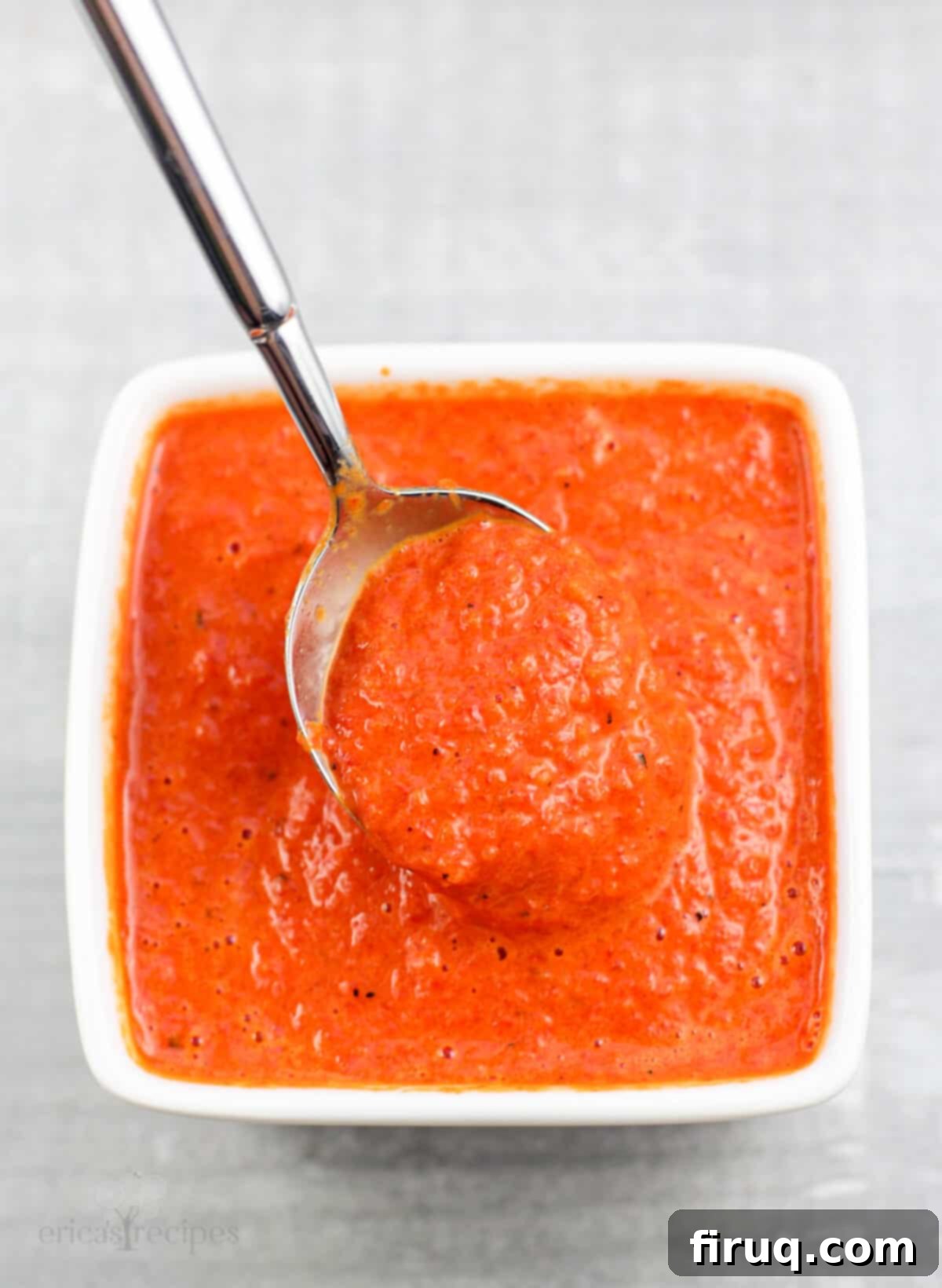
Frequently Asked Questions About Red Pepper Coulis
Absolutely! Making this red pepper coulis suitable for a vegan diet is incredibly simple. You have two excellent options: you can either omit the heavy cream entirely for a lighter, naturally dairy-free version, or you can replace it with a plant-based alternative. Good choices include full-fat coconut cream (which will impart a subtle coconut flavor, complementing the peppers nicely) or a high-quality vegan cream substitute designed for cooking. I generally do not recommend using thin soy or nut milks, as their consistency and fat content are usually too low to achieve the desired richness and texture of this particular coulis. Opt for thicker, creamier vegan alternatives for the best results, ensuring your vegan coulis is just as delicious.
If you don’t own a food processor, don’t worry – you still have several excellent options for achieving a smooth and creamy red pepper coulis. Any high-speed blending machine or tool designed for puréeing will work perfectly. A standard countertop blender is a fantastic choice; simply add your ingredients and blend until smooth, scraping down the sides as needed. An immersion blender (also known as a stick blender) is another convenient tool, allowing you to blend the sauce directly in the saucepan, minimizing cleanup. For those with compact kitchens, a Nutribullet or similar personal smoothie blender can also do the trick, though you might need to blend in smaller batches. The key is to ensure all ingredients are thoroughly puréed to avoid any chunky bits, yielding that signature velvety texture.
Yes, this red pepper coulis freezes beautifully, making it an excellent candidate for meal prepping and having a delicious sauce on hand whenever you need it. To freeze, simply allow the coulis to cool completely after cooking. Then, transfer it to freezer-safe containers with tight-fitting lids, leaving a little headspace for expansion. For ultimate convenience and portion control, you can also freeze individual servings in the wells of an ice cube tray. Once frozen solid, pop out the cubes and store them in a freezer bag. This method allows you to grab just the amount you need, whenever you need it. Frozen coulis will maintain its quality for up to one month. To use, simply thaw overnight in the refrigerator or gently reheat from frozen over low heat on the stovetop or in the microwave.
While the recipe specifically calls for roasted red bell peppers for their deep, sweet, and smoky flavor profile, you could technically use fresh peppers. However, this would significantly change the taste and texture of the coulis. Fresh peppers are crisper and have a brighter, more vegetal flavor and a higher water content. If you choose to use fresh, you would need to roast them yourself first to achieve a similar depth of flavor. This can be done by charring them directly over a gas flame, under a broiler, or by roasting them in the oven until the skin is blistered and slightly blackened, then steaming them in a sealed bag to make peeling easier. The roasting process is crucial as it caramelizes the sugars in the peppers, intensifying their sweetness and creating that characteristic smoky richness that is central to this coulis’s appeal.
Balsamic vinegar adds a unique tangy sweetness and depth to the red pepper coulis. If you don’t have it on hand, a good substitute would be red wine vinegar, which offers a similar acidity and complexity, though it might lack the specific sweet notes of balsamic. Another option is apple cider vinegar, which will provide tanginess but with a fruitier undertone. In a pinch, a squeeze of fresh lemon juice can provide the necessary acidity to balance the sweetness of the peppers, but use it sparingly and taste as you go, as it’s much sharper than vinegar. Remember, the goal is to introduce a bright acidic counterpoint that enhances the overall flavor profile of the sauce.
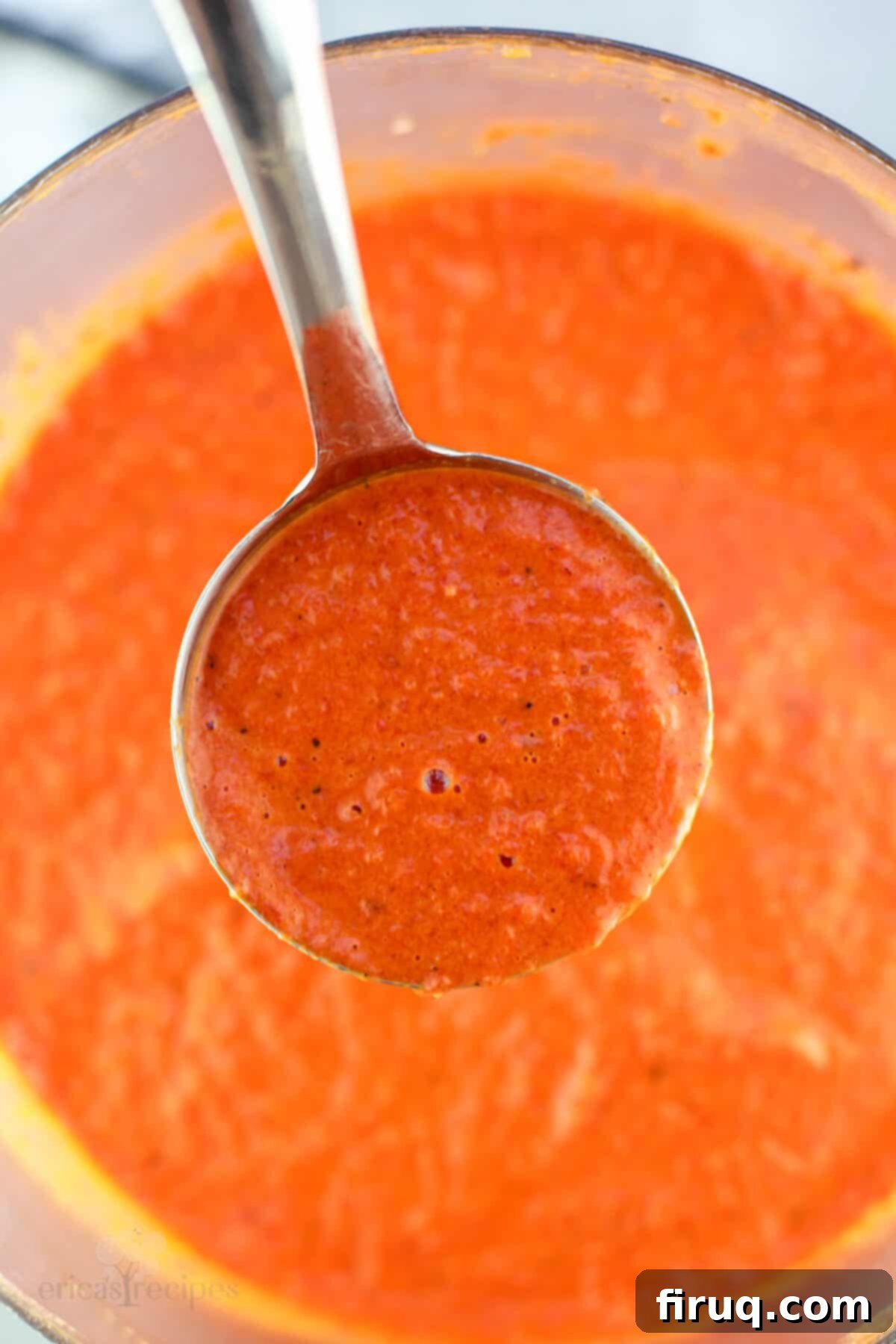
Love this homemade sauce recipe? Then you’ll also love my Huevos Ranchero Sauce with fire-roasted tomatoes, chiles, and roasted red peppers for another vibrant and flavorful addition to your kitchen!
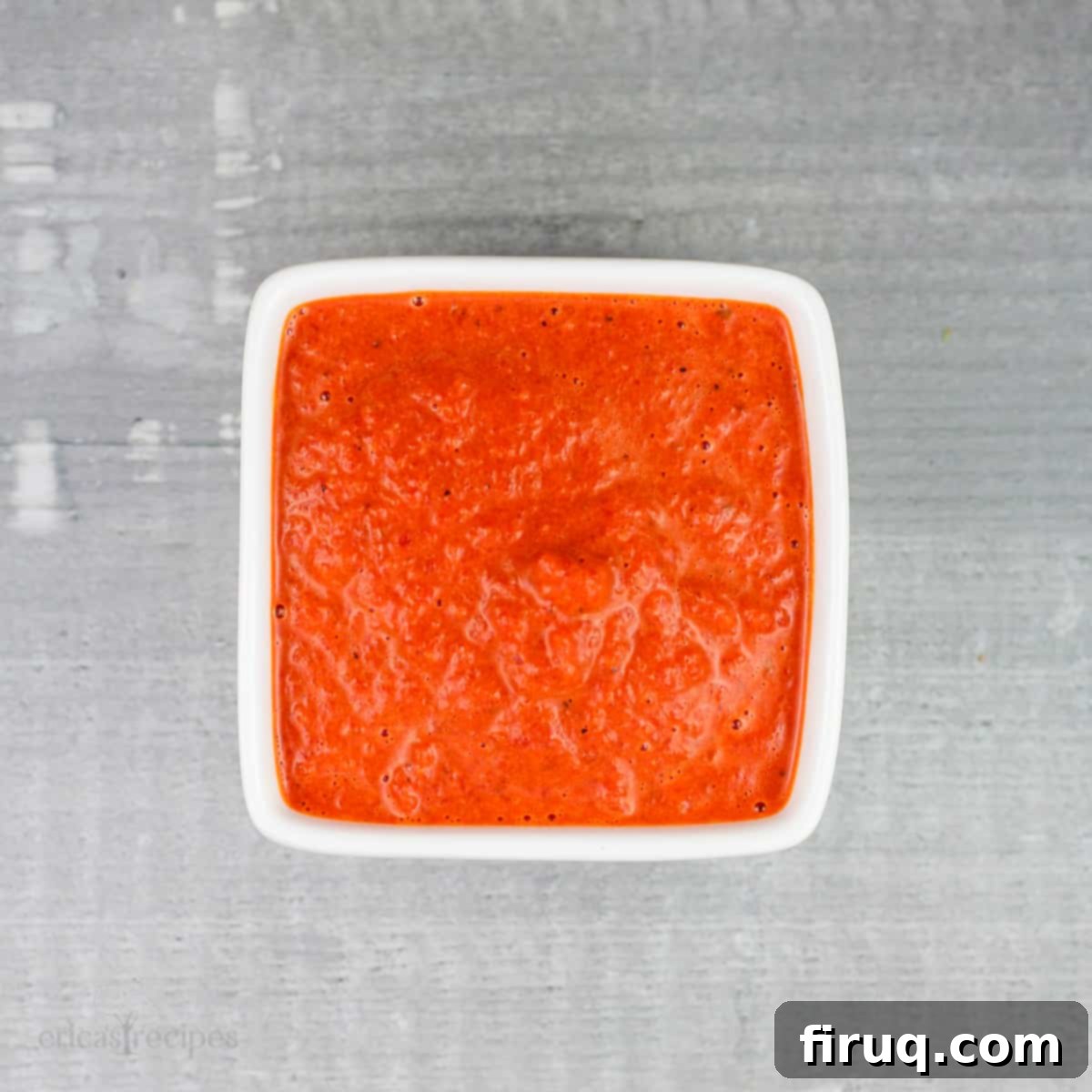
Red Pepper Coulis
Print
Pin
Rate
Equipment
-
food processor
-
skillet
-
saucepan
Ingredients
- ¼ cup extra virgin olive oil
- 1 cup chopped white onion
- 1 clove garlic chopped
- 16 oz roasted red bell pepper drained
- 1 pinch kosher salt
- 1 Tbsp heavy cream
- 2 tsp balsamic vinegar
Instructions
-
Heat 1 Tablespoon of the olive oil in a skillet over high heat. Add the onion and garlic and cook, tossing regularly, until softened and fragrant. Transfer to a food processor.
-
Add the roasted peppers, salt, cream, and remaining olive oil to the onion-garlic mixture in the food processor. Process until smooth. Transfer mixture to a saucepan.
-
Add the balsamic vinegar to the coulis and simmer (*see Notes) 10 minutes. Remove from the heat. Yields ~1-½ cups (12 ounces) sauce.
